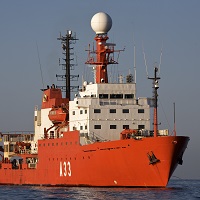Keyword
Northwest Atlantic Ocean (40W)
1436 record(s)
Type of resources
Categories
Topics
INSPIRE themes
Keywords
Contact for the resource
Provided by
Years
Formats
Status
-

Middle Ocean Channels and Fracture Zones: Interaction and Mutual Recent Evolution of Equatorial and Vidal Channels (Equatorial Atlantic)
-

The survey in Div. 3NO of NAFO Regulatory Area was initiated by Spain in 1995. Until 2001, the survey was carried out in spring (May), on board the Spanish vessel C/V Playa de Menduiña (338 GT and 800 HP) using bottom trawl net type Pedreira. Since 2001, the R/V Vizconde de Eza replaced the C/V Playa de Menduíña as the research vessel for the survey, and Campelen net replaced Pedreira net as survey gear. The main objectives of this survey time series are: a) to obtain biomass and abundance indices of the main exploited species, b) to study the structure and distribution of these demersal species in the area.
-

This survey covers the international NAFO Regulation Area in divisions 3NO. It started in 1995 with the only purpose of collecting data for stock assessment of target species down to 700 m, but its aims and research area have widened with time. Currrently, the survey covers a depth range of 50-1500 m and its goals are the following: 1. Regarding the target species (Hippoglossoides platessoides, Limanda ferruginea, Reinhardtius hippoglossoides, Glyptocephalus cynoglossus, Gadus morhua, Sebastes sp, Macrourus berglax, Centroscyllium fabricii and Raja radiata) and other species of commercial interest (Urophycis tenuis; Pandalus borealis) : a. to obtain biomass and abundance indexes, b. to estimate recruitment, c. to investigate the population structure To achieve this, biological information (length, weight, sex, maturity, stomach contents) is obtained from about 30 species, as well as otoliths and gonads from cod, Greenland halibut and roughead grenadier. The remaining fish and commercial invertebrate species are length measured and weighted. 2. Collection of oceanographic data (temperature, salinity, oxygen and fluorescence); 3. Invertebrate data collection: all species are identified to the maximum possible level on board, or otherwise photographed and preserved for later examination at the lab, counted and weighted, with the aim of investigating the benthic invertebrate faunal assemblage and presence of vulnerable species
-

The surveys on NAFO Regulatory Area of Div. 3L (Flemish Pass) were initiated by Spain in 2003. The surveys were carried out by the R/V ¿Vizconde de Eza¿ following the same procedures and using the same bottom trawl net type Campelen.The main objectives of this survey time series are: a) to obtain abundance indices of the main exploited species, b) to study the structure and distribution of these demersal species in the area
-

Estimar la abundancia de las poblaciones de peces demersales Analizar la estructura y diversos parametros biologicos de las especies mas importantes.
-

The survey in Div. 3NO of NAFO Regulatory Area was initiated by Spain in 1995. Until 2001, the survey was carried out in spring (May), on board the Spanish vessel C/V Playa de Menduiña (338 GT and 800 HP) using bottom trawl net type Pedreira. Since 2001, the R/V Vizconde de Eza replaced the C/V Playa de Menduiña as the research vessel for the survey, and Campelen net replaced Pedreira net as survey gear. The main objectives of this survey time series are: a) to obtain abundance indices of the main exploited species, b) to study the structure and distribution of these demersal species in the area.
-

The survey in Div. 3NO of NAFO Regulatory Area was initiated by Spain in 1995. Until 2001, the survey was carried out in spring (May), on board the Spanish vessel C/V Playa de Menduiña (338 GT and 800 HP) using bottom trawl net type Pedreira. Since 2001, the R/V Vizconde de Eza replaced the C/V Playa de Menduíña as the research vessel for the survey, and Campelen net replaced Pedreira net as survey gear. The main objectives of this survey time series are: a) to obtain biomass and abundance indices of the main exploited species, b) to study the structure and distribution of these demersal species in the area.
-
<p>Understanding the ecosystems of hydrothermal sites and their surrounding areas in the Atlantic: mapping and characterization of the geological and geochemical context, characterization of habitats, inventory of biodiversity in hydrothermal ecosystems and surrounding areas and geobiological connectivity and interaction.</p>
-
Weekly cruise to monitorize physical and chemical variables in Rías Altas (Galicia)
-
Weekly cruise to monitorize physical and chemical variables in Rías Altas (Galicia)
 Catálogo de datos del IEO
Catálogo de datos del IEO